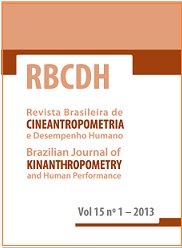Behavioral and biological correlates of medicine use in type 2 diabetic patients attended by Brazilian public healthcare system
DOI:
https://doi.org/10.1590/1980-0037.2013v15n1p82Abstract
The relationship between physical activity and the use of medicines is not clear. The purpose of this study was to investigate this relationship between the level of physical activity and the use of medications by type 2 diabetic patients who were attended in the Brazilian public healthcare system. The sample was composed of 121 Brazilian diabetic patients, of both genders, attended by the public healthcare system. Body fat (estimated by anthropometry and bioelectrical impedance), physical activity (measured by Baecke’s questionnaire), and the participant’s use of medicines (during the 15 days before evaluation) were assessed. There was a relationship between the use of medicines and: gender (r = 0.18; p = 0.045), body mass index (BMI) (r = 0.22; p = 0.012), waist circumference (r = 0.19; p = 0.029), body fat percentage (r = 0.21; p = 0.016), age (r = 0.23; p = 0.009), and level of physical activity (r = -0.22; p = 0.012). Linear regression included in the multivariate model only age (? = 0.718; p = 0.057), BMI (?= 0.057; p = 0.022), and level of physical activity (? = -0.176; p = 0.044). In conclusion, physical activity decreases medicinal use independent of age or obesity.



